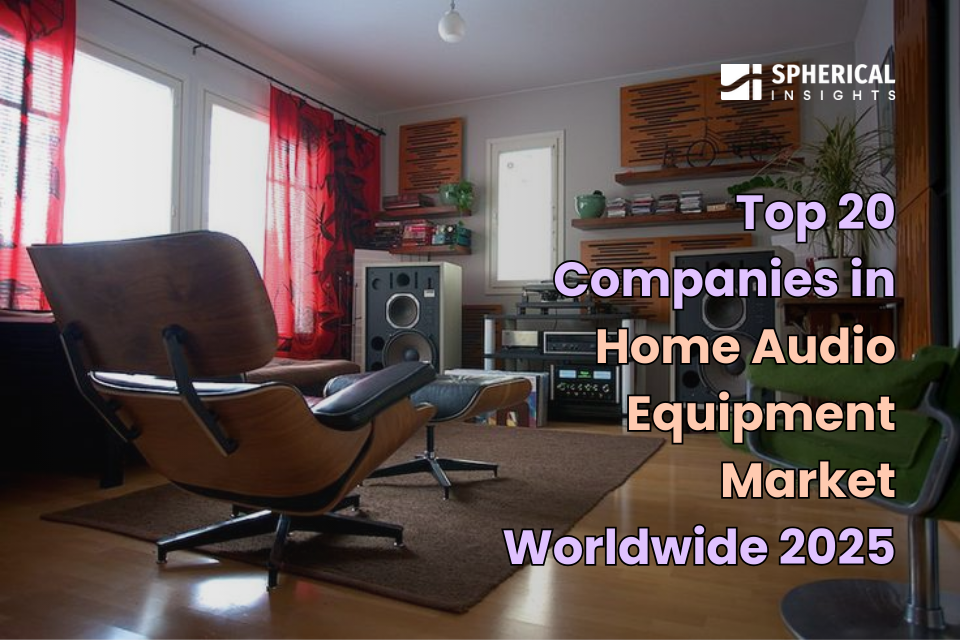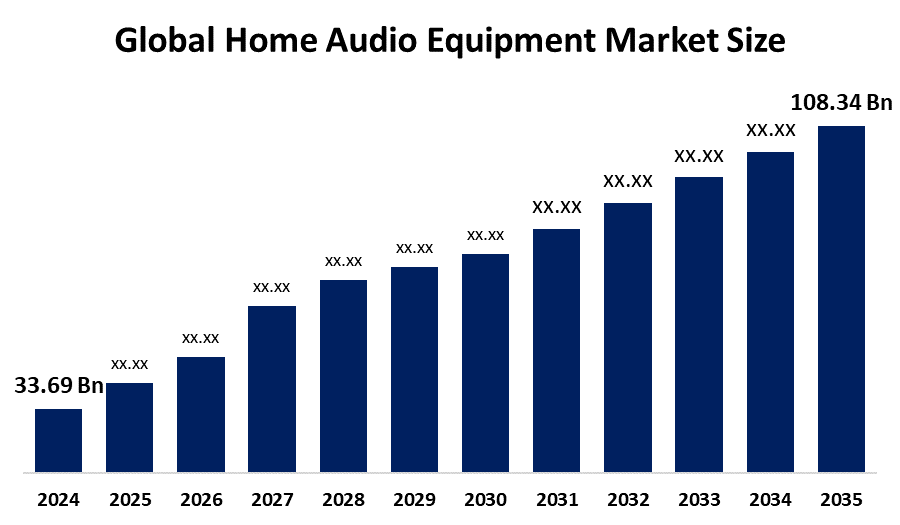
Top 20 Companies in Home Audio Equipment Market Worldwide 2025: Market Research Report (2024–2035)
RELEASE DATE: Sep 2025 Author: Spherical InsightsRequest Free Sample Speak to Analyst
Description
According to a research report published by Spherical Insights & Consulting, The Global Home Audio Equipment Market Size is projected to Grow from USD 33.69 Billion in 2024 to USD 108.34 Billion by 2035, at a CAGR of 11.2% during the forecast period 2025–2035. Some of the major factors driving the market growth are the increasing number of physical showrooms, the proliferation of e-commerce platforms, the growing demand for home entertainment systems among the general public, and the growing preferences for wireless audio devices' convenience and aesthetic appeal.
Introduction
The market for electronic devices that enhance audio quality within the home is called "global home audio equipment market." This market consists of both wired and wireless items such as soundbars, home theater systems, speakers, and receivers. Devices are increasingly using smart technologies such as voice assistants, Bluetooth, and Wi-Fi for systems that connect with TVs, smartphones, and smart home systems. Industries are also aiding the growth of the global home audio market through the aesthetics and usability of wireless audio systems (Bluetooth and wireless fidelity (Wi-Fi) speakers), as opposed to wired systems. The elimination of messy wiring and ability to connect various devices in each room is largely the reason for this movement. The freedom of positioning with a wireless system in addition to pairing with different streaming services and smart appliances. For example, Rode's recent release, in April 2023 highlights the advances in wireless technology. The latest Wireless GO II can now be remoteRODECaster Pro II. The Streamer X offers professional-grade audio inputs and outstanding video streaming capabilities.
Navigate Future Markets with Confidence: Insights from Spherical Insights LLP
The insights presented in this blog are derived from comprehensive market research conducted by Spherical Insights LLP, a trusted advisory partner to leading global enterprises. Backed by in-depth data analysis, expert forecasting, and industry-specific intelligence, our reports empower decision-makers to identify strategic growth opportunities in fast-evolving sectors. Clients seeking detailed market segmentation, competitive landscapes, regional outlooks, and future investment trends will find immense value in the full report. By leveraging our research, businesses can make informed decisions, gain a competitive edge, and stay ahead in the transition toward sustainable and profitable solutions.
Unlock exclusive market insights-Download the Brochure now and dive deeper into the future of the Home Audio Equipment Market.
Home Audio Equipment Market Size & Statistics
- The Market Size for Industrial Valves Was Estimated to be Worth USD 33.69 Billion in 2024.
- The Market Size is Going to Expand at a CAGR of 11.2% Between 2025 and 2035.
- The Global Home Audio Equipment Market Size is Anticipated to Reach USD 108.34 Billion by 2035.
- North America is expected to generate the highest demand during the forecast period in the Home Audio Equipment Market.
- Asia Pacific is expected to grow the fastest during the forecast period in the Home Audio Equipment Market.

Regional growth and demand
Asia Pacific is expected to grow the fastest during the forecast period in the home audio equipment market. A growing middle class with more disposable income is present in this region, especially in major markets like China and India, which encourages consumers to spend more on electronics. Additionally, leading electronics producers in nations like China, South Korea, and Japan encourage the development and accessibility of audio technologies. The need for home audio equipment is also being driven by urbanization and young, tech-savvy populations who want the newest gadget at home.
North America is expected to generate the highest demand during the forecast period in the home audio equipment market. Driven by a developed American market that is well-known for its high level of consumer spending on high-end home entertainment systems. The growing demand for high-fidelity audio equipment and streaming services, which increase demand for high-end home audio systems, are major drivers of North America's growth.
Top 10 Home Audio Equipment Trends
1.Wireless Audio Dominance
2.Smart Home Integration
3.Miniaturization & Sleek Design
4.Dolby Atmos & Surround Sound Expansion
5.AI-Enhanced Audio Devices
6.Rise of High-Resolution Audio
7.Streaming-Centric Consumption
8.Growth in Developing Markets
9.Online Sales Channels Surge
10.Sustainability & Energy Efficiency
1. Wireless Audio Dominance
As consumers increasingly choose wireless speakers, soundbars, and home theater-in-a-box (HTIB) systems over conventional wired setups, wireless audio dominance is a reflection of a significant shift in consumer preferences. Convenient cable-free installation, increased mobility, and smooth Bluetooth and Wi-Fi connectivity with smartphones, smart TVs, and streaming services are what are driving this shift. Wireless audio solutions are the go-to option for contemporary entertainment settings because they provide a clutter-free appearance and an easy-to-use interface as homes get smarter and more connected.
2. Smart Home Integration
By integrating voice assistants like Alexa and Google Assistant straight into speakers and soundbars, smart home integration is revolutionizing the market for home audio equipment. This enables users to use voice commands to control playback, volume, input switching, and even other connected appliances. Audio systems provide improved automation, multi-room synchronization, and smooth communication with lighting, thermostats, and entertainment platforms as they integrate into larger smart ecosystems, making living more convenient and integrated.
3. Miniaturization & Sleek Design
The market for home audio equipment is being redefined by sleek design and miniaturization as consumers, especially in urban areas, look for small systems that produce strong sound without sacrificing aesthetics. With their space-saving configurations, wall-mountable options, and minimalist profiles, modern audio devices are designed to blend in perfectly with modern interiors. These systems use cutting-edge acoustic technologies to provide rich, immersive audio experiences despite their smaller size.
4. Dolby Atmos & Surround Sound Expansion
Dolby Atmos and DTS:X are two examples of cutting-edge audio formats that are revolutionizing home entertainment by introducing theater-quality immersion into living rooms. These technologies create a 360-degree soundscape by delivering multidimensional audio that moves around the listener through object-based sound design. Manufacturers are incorporating these formats into soundbars, AV receivers, and streaming platforms in response to the growing consumer demand for high-fidelity experiences, which is bringing surround sound closer to the general public.
5. AI-Enhanced Audio Devices
By incorporating clever features like adaptive sound profiling, voice recognition, and conversational interfaces, AI-enhanced audio devices are transforming user interaction and sound personalization. These systems provide customized acoustic experiences by automatically optimizing audio output based on user preferences, listening environments, and content types. While conversational AI enables intuitive control and integration with smart ecosystems, voice-controlled functionality facilitates smooth hands-free operation.
Empower your strategic planning:
Stay informed with the latest industry insights and market trends to identify new opportunities and drive growth in the home audio equipment market. To explore more in-depth trends, insights, and forecasts, please refer to our detailed report.
Top 16 Companies Leading the Home Audio Equipment Market
1.Sonos
2.Sony
3.Bose
4.Samsung Electronics
5.Panasonic
6.Amazon
7.Google
8.Bowers & Wilkins
9.Boston Acoustics
10.Dynaudio
11.Klipsch Audio Technologies
12.Sennheiser
13.LG Electronics
14.Yamaha Corporation
15.Harman International
16.Denon
17.Others
1. Sonos
Headquarters - Santa Barbara, California, the US.
A company called Sonos Inc. (Sonos) focuses on making products that enhance the sound experience. The design and development of wireless audio systems is one of the company's primary operations. Sonos provides a variety of products, including headphones, home theater systems, wireless speakers, portable speakers, and audio components. It uses the Era, Roam, Move, Ray, Beam, Arc, and Ace brands to market its goods. Consumers use the company's products for home entertainment and personal listening. Sonos distributes its goods via distributors, online merchants, physical retail locations, and its own website, sonos.com.
2. Sony
Headquarters - Minato-Ku, Tokyo, Japan.
Sony Group Corp. (Sony) creates, designs, manufactures, and sells electronic instruments, equipment, and parts. The company's products include televisions, still and video cameras, mobile phones, image sensors, audio and video recorders and players, and game hardware and software. Sony also works in the entertainment sector, producing and distributing animation films, managing and licensing music, and supervising the creation, acquisition, and distribution of films and television shows. The business caters to the professional, industrial, and consumer markets. The company uses factories, authorized independent service centers, authorized servicing dealers, call centers, service centers, online support networks, and subsidiaries to run its business.
3. Bose
Headquarters - Framingham, Massachusetts, United States.
The privately held American business Bose Corporation is well-known for its innovative sound systems and groundbreaking work in audio technology. Dr. Amar G. Bose founded the business in 1964, and since then, it has established a solid reputation for providing high-end audio experiences in the consumer, business, automotive, and aviation sectors. Bose is most recognized for its high-fidelity home audio systems, noise-canceling headphones, and innovative speaker designs that prioritize user-centric engineering and acoustic performance.
4. Samsung Electronics
Headquarters - Seoul, South Korea
An affiliate of the Samsung Group, Samsung Electronics Co Ltd (Samsung) manufactures consumer electronics, mobile communications and information technology, and device solutions. TVs, refrigerators, network systems, audio equipment, medical devices, printers, air conditioners, computers, monitors, and digital cameras are among the products offered by the company. In addition, it produces tablets, smartphones, LCD and LED panels, and associated accessories.
5. Panasonic
Headquarters - Kadoma-shi, Osaka, Japan.
A variety of electric and electronic products are developed, manufactured, sold, and serviced by Panasonic Holdings Corp. (Panasonic). TVs, fixed phones, digital cameras, video equipment, home audio equipment, rice cookers, lamps, wiring devices, air conditioners, air purifiers, and bicycles are all part of Panasonic's product line. Additionally, it sells computer systems, tablets, projectors, batteries, electric motors, semiconductors, LCD panels, mounting machines, welding equipment, and electronic components. Its goods and services serve a broad spectrum of clients and uses in sectors like consumer electronics, automotive, and energy.
Are you ready to discover more about the industrial valves market?
The report provides an in-depth analysis of the leading companies operating in the global home audio equipment market. It includes a comparative assessment based on their product portfolios, business overviews, geographical footprint, strategic initiatives, market segment share, and SWOT analysis. Each company is profiled using a standardized format that includes:
Company Profiles
1.Sonos
- Business Overview
- Company Snapshot
- Products Overview
- Company Market Share Analysis
- Company Coverage Portfolio
- Financial Analysis
- Recent Developments
- Merger and Acquisitions
- SWOT Analysis
- Samsung Electronics
- Bowers & Wilkins
- Boston Acoustics
- Klipsch Audio Technologies
- LG Electronics
- Yamaha Corporation
- Harman International
- Others
Conclusion
The Global Home Audio Equipment Market Size is undergoing rapid evolution fueled by consumer demand for an immersive, wireless, and smart-enabled audio experience. Voice assistance built into home systems, improved designs, and the use of new audio formats like Dolby Atmos are changing consumer expectations. Regional growth is being driven by the expanding middle class in Asia Pacific and the rise in purchasing premium entertainment systems in North America. Product innovation is being influenced by personalization and sustainability both driven by AI. Market leaders are recognizing and taking advantage of these shifts to broaden product offerings and exploit emerging opportunities. Strategic insights and adoption of technology will be paramount in remaining competitive in this evolving landscape.
About the Spherical Insights & Consulting
Spherical Insights & Consulting is a market research and consulting firm which provides actionable market research study, quantitative forecasting and trends analysis provides forward-looking insight especially designed for decision makers and aids ROI.
Which is catering to different industry such as financial sectors, industrial sectors, government organizations, universities, non-profits and corporations. The company's mission is to work with businesses to achieve business objectives and maintain strategic improvements.
CONTACT US:
For More Information on Your Target Market, Please Contact Us Below:
Phone: +1 303 800 4326 (the U.S.)
Phone: +91 90289 24100 (APAC)
Email: inquiry@sphericalinsights.com, sales@sphericalinsights.com
Contact Us: https://www.sphericalinsights.com/contact-us
Need help to buy this report?